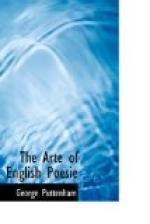[Illustration: diagram of four lines with line
one connected to line three
and line two connected to line four.]
Scituation in Concord ---------- \
----------
) \
----------
/ )
----------
/
Scituation in Measure ------ ------------ ------- --------- -------- ------------ --------- ------ --------- --------- -------- ------------ ------- ------ ------ ------------ ------------ ------ ------
Where ye see the concord or rime in the third distance, and the measure in the fourth, sixth or second distaunces, where of ye may deuise as many others as ye list, so the staffe be able to beare it. And I set you downe an occular example: because ye may the better conceiue it. Likewise it so falleth out most times your ocular proportion doeth declare the nature of the audible: for if it please the eare well, the fame represented by delineation to the view pleaseth the eye well and e conuerso: and this is by a naturall simpathie, betweene the eare and the eye, and betweene tunes & colours euen as there is the like betweene the other sences and their obiects of which it apperteineth not here to speake. Now for the distances vsually obserued in our vulgar Poesie, they be in the first second third and fourth verse, or if the verse be very short in the fift and sixt and in some maner of Musickes farre aboue.
And the first distance for the most part goeth all by distick or couples of verses agreeing in one cadence, and do passe so speedily away away and so often returne agayne, as their tunes are neuer lost, nor out of the eare, one couple supplying another so nye and so suddenly, and this is the most vulgar proportion of distance or situation, such as vsed Chaucer in his Canterbury tales, and Gower in all his workes.
[Illustration: diagram of four lines with line one connected to line two and line three connected to line four.]
Second distance is, when ye passe ouer one verse, and ioyne the first and the third, and so continue on till an other like distance fall in, and this is also usuall and common, as




